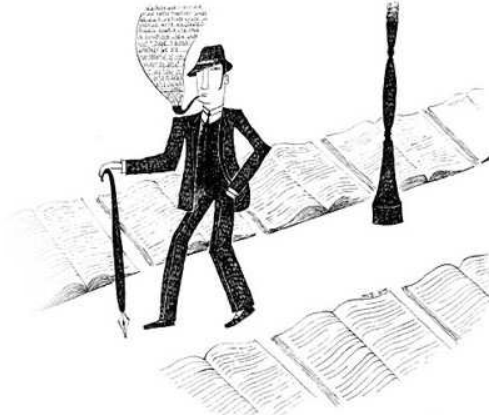Flâneur is a type of person shaped by the dynamics of modern urban life, and this figure has become an important subject of discussion in various fields such as literature, art, and sociology. Although the Turkish Language Association (TDK) defines it as a person who "lives day by day without worrying about tomorrow, living a carefree, chaotic life," the original meaning of the flâneur refers to a conscious observer and a traveler who closely examines city life. Derived from the French verb "flâner," the term is thought to have been used for the first time in the 16th century. The flâneur is not just a wanderer but a figure who observes the experiences cities offer through art.

Flâneur (Source: ResearchGate)
Flâneur and Modernity
The flâneur took shape in the 19th century, especially with the rise of modernity in Paris. Charles Baudelaire described the flâneur as an observer of modern city life, portraying this figure as one who roams the crowded streets of Paris and conveys his observations through art and literature. Walter Benjamin, in his work "The Arcades Project," defines the flâneur as a traveler of the modern city and describes him as a solitary observer within the crowds. Rather than participating in the speed and chaos of urban life, the flâneur watches it from the outside. This allows the flâneur to be an alienated observer of society.
Flâneur and Interaction with the City
The flâneur is typically found in large metropolises to observe urban life, and the wide boulevards expanded by Haussmann’s reconstruction of Paris offer opportunities to explore the city. The flâneur continuously makes observations about the city's mobility and social structure, but rejects becoming a part of the city. As the flâneur discovers the details of the urban space, he simultaneously translates these discoveries into an artistic language. Invisibility and distance are essential characteristics that enhance the flâneur’s ability to observe.
Flâneur, Bohemian, and Dandy Distinction
The flâneur is often confused with the bohemian and dandy figures. While the bohemian is described as an individual who lives day by day and enjoys the present moment, the flâneur takes on a more conscious role as an observer. The bohemian embraces a life detached from social responsibilities, often living in economic insecurity, while the flâneur deeply observes urban life. The dandy, unlike the flâneur, is an individual with economic security, often coming from an established family, and indifferent to social issues. The dandy is notable for his elegance, while the flâneur observes and translates his observations into artistic form.
Flâneur in Literature and Art
The figure of the flâneur holds an important place in literature and art. In the Ottoman period, Ahmet Mithat Efendi’s "Felatun Bey" and Recaizade Mahmut Ekrem’s "Bihruz Bey" are examples of flâneur figures that critique the Western-style lifestyle. In the Republican period, Yusuf Atılgan’s "Aylak Adam" explored the psychological depth of the flâneur typology. Modern literature emphasizes the flâneur’s identity as an observer while examining his relationship with urban life.
Edgar Allan Poe (1840)
One of the first writers to indirectly address the concept of the flâneur was Edgar Allan Poe. In his story "The Man of the Crowd," the narrator follows a man in the crowd and observes the complexities of urban life. Poe presented the concept of the flâneur without naming it, but his work has been an important source of inspiration for the spread of the concept.
Charles Baudelaire (1845)
Baudelaire is one of the first people to turn the concept of the flâneur into a literary figure. In "The Painter of Modern Life and Other Essays," he defines the flâneur as a gentleman wanderer of the city streets. According to him, the flâneur is an individual who is at the heart of movement, feels at home everywhere, but can be hidden from the world.
Walter Benjamin (1929)
Walter Benjamin defines the flâneur as an observer of city life and describes him as a figure who helps understand modern urban life. According to Benjamin, the flâneur walks through city streets like a detective, gathering clues and deciphering the codes of the metropolis.
Edmund White (2001)
In modern times, Edmund White discusses the flâneur in his book "Flâneur: A Walk Between the Paradoxes of Paris," exploring the place of this concept in the modern world. White sees flânerie as a lifestyle that avoids haste and makes effective use of idle time.
Nassim Taleb (2004)
In his book "Antifragile," Nassim Taleb describes the flâneur as a "master of trial and error." The flâneur avoids rigid plans and makes spontaneous decisions, continuously evaluating alternatives.
Famous Flâneurs in History
- Henry David Thoreau
- Albert Einstein
- Charles Darwin
- Virginia Woolf
- Friedrich Nietzsche
- Ludwig Van Beethoven
- Leo Tolstoy
Characteristics of the Flâneur Concept
- Wandering: The flâneur travels the world, gaining new experiences without focusing on a specific goal.
- Observation: Flâneurs pay attention to the details around them and observe the environment impartially.
- Documentation: They have a habit of sharing and recording the experiences they discover.
- Experimentation: Flâneurs are open to trying new ideas and are willing to explore innovations.
- Flexibility: They embrace spontaneous experiences by living without making plans.
The Female Reflection of the Flâneur: Flâneuse
The flâneur is typically considered a male figure. However, with feminist approaches, the concept of the flâneur has been questioned, and the term "flâneuse" has emerged. The flâneuse refers to women who wander in public spaces and examines their relationships with urban environments. The flâneuse presents the mobility and observations of the flâneur from a female perspective.
Flâneur in the 21st Century
The concept of the flâneur has taken on a new dimension with the impact of digitization. Today, new terms such as "virtual flâneur" or "digital flâneur" express the experience of urban life in a digital environment. Individuals who observe cities through mobile devices explore their surroundings by roaming virtual platforms. With the development of technology, the flâneur exists not only in physical streets but also in digital spaces.

